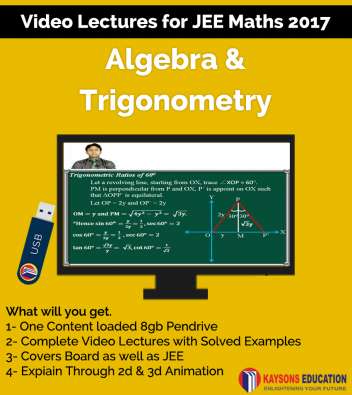Trignometry for IIT JEEE
Trigonometric Functions and Identities
Day 1: Trigonometric Ratio and Identities Angle and its Measurement, Measurement of an Angle, Sexagesimal System (degree measure), Centesimal System (grade measure), Circular System (radian measure), Number of radians in an Angle subtended by an Arc of a Circle at the Centre, Definitions of Trigonometric Ratio or Circular Functions, Coplanar vectors, Signs of Trigonometric Ratios, Trigonometrical Identities, Trigonometric Ratio of Standard Angles, Allied Angles.
Day 2: Trigonometrical Rations of Angle(90o – θ) in Terms of θ, Trigonometrical Rations of (90o + θ) in Terms of θ, Trigonometrical Rations of (180o – θ) in Terms of θ, Trigonometrical Rations of (180o + θ) in Terms of θ, Trigonometrical Rations of (360o – θ) in Terms of θ, Trigonometric Rations of Compound Angles, The Addition Formulae, Subtraction Formulae, Transformation Formulae, Trigonometric Rations of Multiple Angles, Trigonometric Rations of Sub multiple of an Angle.
Day 3: Identities, Graphs of Trigonometric Functions, Trigonometric Functions and Identities, Maximum and Minimum Values of Trigonometrical Functions Trigonometry.
Day 4: Illustration.
Day 5: Illustration.
Trigonometric Equation
Day 1: Trigonometric Equations and Inequations, Properties and Solutions of Triangles, Napier’s analogy.
Day 2: Straight Line, Cartesian equation of straight line, Cartesian form, Perpendicular distance of a point from a line (Cartesian form) (Vector form), Reflection or image of a point in a straight line (Cartesian form) (Vector form).
Day 3: Illustration.
Day 4: Illustration.
Day 5: Illustration.
Logarithms and Their Properties
Day 1: Logarithmic Function, Graph of Logarithmic Function, Properties of Logarithmic Function, Changing of Base.
Algebra for IIT JEE
Complex Number
Day 1: Complex Numbers, Sum of two complex numbers, Product of two complex numbers, Difference of two complex numbers, Division of two complex numbers, Modulus and argument of a complex number, Polar form of a Complex Number, The geometrical representation of complex numbers, Vector representation of complex numbers, Conjugate to complex numbers, The following relations be committed to memory.
Day 2: Mehod for square root of a complex numbers, Cube roots of unity 1,ω,ω^2.
Day 3: De-Moivre’s Theorem, n-th roots of a complex number, Representation of roots of unity, Common properties of roots of unity.
Day 4: Properties of Moduli, Properties of Arguments, Some useful formulae for Modulus and Amplitude.
Day 5: Concept on Anti-clockwise rotation, General formula for rotation, Passage type questions.
Day 6: Illustration.
Day 7: Illustration.
Theory of Quadratic Equations
Day 1: Roots of the equation, Sum and Product of the roots, To find the equation whose roots are α and β, Nature of the roots, Sign of the expression, Modulus Function, Greatest Integer function, Common roots, Inequalities, Certain important definitions.
Day 2: Illustration.
Day 3: Illustration.
Permutations and Combinations
Day 1: Definitions of Permutation, Definitions of Combination, Fundamental Theorem, Important Results.
Day 2: Other Important Concepts on Permutations and Combinations.
Day 3: Illustration.
Probability
Day 1: Some Definitions, Sample Space, Event, Mutually Exclusive Events, Equally Likely Events, Exhaustive Events, Classical Definition of Probability, Odds in favour and odds against an event, Axiomatic approach to probability Theory, Axioms of Probability, Conditional Probability, Multiplication Theorem, Independent events, Important Remarks, Partition of a sample Space, Theorem of Total Probability for Compound Events, Binomial Distributions, Theorem, Use of Multinomial Theorem, Alternative Concept of Inverse Probability (Baye’s rule).
Day 2: Illustration.
Day 3: Illustration.
DVD 2
Progressions & Series
Day 1: Arithmetical Progression, Geometrical Progression, Definition, nth term of a G.P., Sum of n terms of a G.P., Single Geometric Mean Between a and b, Product of n geometric means = Gn, An Important Note.
Day 2: Arithmetic-geometric series, Definition, Natural Numbers, Method of difference, Harmonical Progression (H.P.), nth term of H.P., Harmonic mean (single), n Harmonic Means Between a and b, Relations between A, G and H.
Day 3: Illustration.
Binomial Theorem
Day 1: Statement of binomial theorem for positive integral index, General term, Tr + 1, Binomial coefficients of terms equidistant from the beginning and the are equal, Number of terms and middle term, Values of Binomial Coefficients, Term containing xr will occur in Tr + 1 for (1 + x)n and it will be 〖(_ ^n)C〗_r x^r, Term independent of x in the expansion of (x + a)n, Terms equidistant from the beginning and end of the binomial expansion (x+a)n. Day 2: Illustration. Day 3: Illustration. Determinants (DVD-2) Day 1 Definition, Aid to memory, Rule, Expansion with respect to first column, Properties.
Day 2: Cofactor and Minors, Differentiation of a determinant, Integration of a Determinant, Factor of certain standard determinants. Remember the results, System of linear Equations, Non – homogeneous Equations in two unknowns, Homogeneous linear equation in two unknowns, Non – homogeneous linear equations in three unknowns, Homogeneneous linear equation, Three equations in two unknowns, Gist of discussion in simple language.
Day 3: Illustration.
Day 4: Illustration.
Matrices
Day 1: Definition, Various Types of Matrix, Properties of Matrix Multiplication.
Day 2: Various Kinds of Matrices, The Transpose of Matrix, Properties of Transpose, Symmetric Matrix, Definition of Adjoint of a Matrix, Working rule for finding the adjoint of A, Rule to write the cofactor of an element aij, The Inverse of Matrix, Properties, Inverse of a matrix is unique, Rank of a Matrix, Sub –matrix of order r, The rank of a given matrix A is said to be r if, Working Rule, Solution of Equations, Representation of equations in matrix form, Nature of Solution.
Day 3: Illustration.
Day 4: Illustration.
Mean and Variance
Day 1: Introduction, Discrete Random Variable, Probability Distribution, Probability Distribution, Mean of a Discrete Random Variable, Variance of a Discrete Random Variable.
Day 2: Illustration.
Linear Programming
Day 1: Introduction, Discrete Random Variable, Probability Distribution, Probability Distribution, Mean of a Discrete Random Variable, Variance of a Discrete Random Variable.
Day 2: Some Definitions and Results, Feasible Solution, Infeasible solution, Feasible Region, Optimal Feasible Solution, Convex Set, Theorem, Fundamental Extreme point Theorem, Graphical Methods of Solving Linear Programming Problems, Corner-Point Method, Iso-Profit or Iso-Cost Method, Different Types f linear Programming Problems, Diet Problems, Optimal Product Line Problems, Transportation Problems.
Day 3: Illustration.


